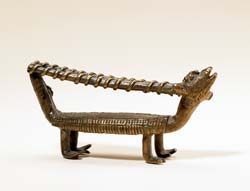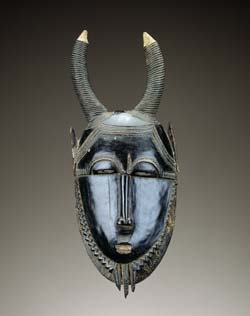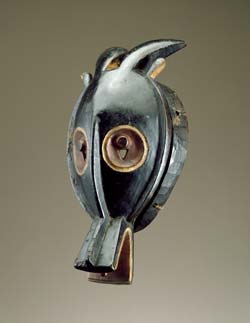
The focus on antelopes in African art seems to be on the animal that is hunted versus the damage the animal can do. Antelopes are wild animals, even if some of the smallest may be kept as pets until they are eaten.
The Guro peoples have a number of antelope masks. Some are danced primarily for entertainment, while others represent powerful male spirits too dangerous and destructive to allow into the village. The masks of the neighboring Yaure peoples are emblems for the spirit power yu and have human and animal features. The Yaure mask (acc. no. 91-21-1) has a human face surmounted by a pair of antelope horns and was worn in a celebratory communal theater that was seen by both men and women.
 A small antelope, like the duiker, is one of the central characters in Yaka initiation tales where it tricks larger, more dangerous animals. As a reminder of a tale's message, antelopes can be carved on the initiation masks used in the training camps. The Asante peoples depict antelopes in weights used to measure gold dust. An antelope with very long horns (acc. no. 83-11-19) most often refers to the uselessness of hindsight; in other words, "It is always too late to say 'Had I known!'" In general, antelope images refer to the proverbs, "When the antelope is unhappy, it is the hunter who is the cause" and "Two small antelopes can beat a big one." A small antelope, like the duiker, is one of the central characters in Yaka initiation tales where it tricks larger, more dangerous animals. As a reminder of a tale's message, antelopes can be carved on the initiation masks used in the training camps. The Asante peoples depict antelopes in weights used to measure gold dust. An antelope with very long horns (acc. no. 83-11-19) most often refers to the uselessness of hindsight; in other words, "It is always too late to say 'Had I known!'" In general, antelope images refer to the proverbs, "When the antelope is unhappy, it is the hunter who is the cause" and "Two small antelopes can beat a big one."

Face mask
Yaure peoples, Côte d'Ivoire
Early to mid-20th century
Wood, pigment
Museum purchase, 91-21-1
|

Antelope mask
Guro peoples, Côte d'Ivoire
Early to mid-20th century
Wood, pigment, plant fiber
Museum purchase, 98-16-1
|
|
|
|